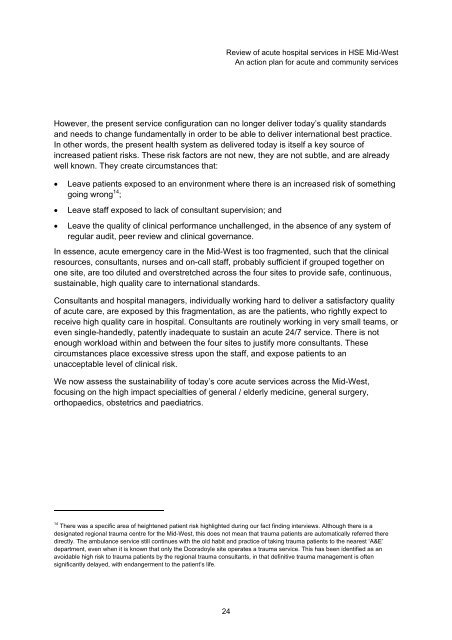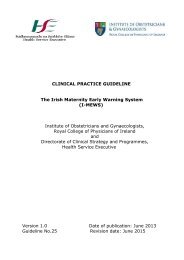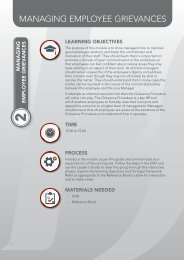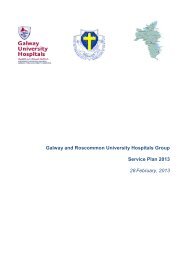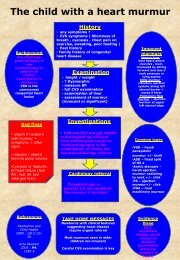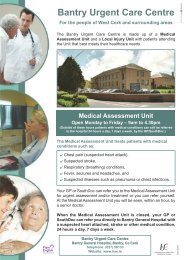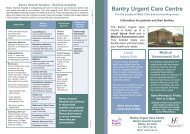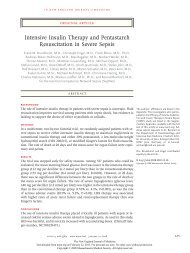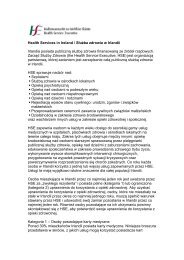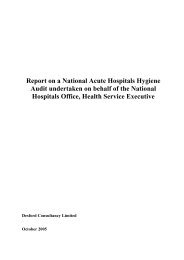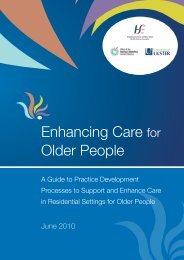Review of acute hospital services in the Mid - Health Service Executive
Review of acute hospital services in the Mid - Health Service Executive
Review of acute hospital services in the Mid - Health Service Executive
- TAGS
- acute
- www.hse.ie
You also want an ePaper? Increase the reach of your titles
YUMPU automatically turns print PDFs into web optimized ePapers that Google loves.
<strong>Review</strong> <strong>of</strong> <strong>acute</strong> <strong>hospital</strong> <strong>services</strong> <strong>in</strong> HSE <strong>Mid</strong>-West<br />
An action plan for <strong>acute</strong> and community <strong>services</strong><br />
However, <strong>the</strong> present service configuration can no longer deliver today’s quality standards<br />
and needs to change fundamentally <strong>in</strong> order to be able to deliver <strong>in</strong>ternational best practice.<br />
In o<strong>the</strong>r words, <strong>the</strong> present health system as delivered today is itself a key source <strong>of</strong><br />
<strong>in</strong>creased patient risks. These risk factors are not new, <strong>the</strong>y are not subtle, and are already<br />
well known. They create circumstances that:<br />
• Leave patients exposed to an environment where <strong>the</strong>re is an <strong>in</strong>creased risk <strong>of</strong> someth<strong>in</strong>g<br />
go<strong>in</strong>g wrong 14 ;<br />
• Leave staff exposed to lack <strong>of</strong> consultant supervision; and<br />
• Leave <strong>the</strong> quality <strong>of</strong> cl<strong>in</strong>ical performance unchallenged, <strong>in</strong> <strong>the</strong> absence <strong>of</strong> any system <strong>of</strong><br />
regular audit, peer review and cl<strong>in</strong>ical governance.<br />
In essence, <strong>acute</strong> emergency care <strong>in</strong> <strong>the</strong> <strong>Mid</strong>-West is too fragmented, such that <strong>the</strong> cl<strong>in</strong>ical<br />
resources, consultants, nurses and on-call staff, probably sufficient if grouped toge<strong>the</strong>r on<br />
one site, are too diluted and overstretched across <strong>the</strong> four sites to provide safe, cont<strong>in</strong>uous,<br />
susta<strong>in</strong>able, high quality care to <strong>in</strong>ternational standards.<br />
Consultants and <strong>hospital</strong> managers, <strong>in</strong>dividually work<strong>in</strong>g hard to deliver a satisfactory quality<br />
<strong>of</strong> <strong>acute</strong> care, are exposed by this fragmentation, as are <strong>the</strong> patients, who rightly expect to<br />
receive high quality care <strong>in</strong> <strong>hospital</strong>. Consultants are rout<strong>in</strong>ely work<strong>in</strong>g <strong>in</strong> very small teams, or<br />
even s<strong>in</strong>gle-handedly, patently <strong>in</strong>adequate to susta<strong>in</strong> an <strong>acute</strong> 24/7 service. There is not<br />
enough workload with<strong>in</strong> and between <strong>the</strong> four sites to justify more consultants. These<br />
circumstances place excessive stress upon <strong>the</strong> staff, and expose patients to an<br />
unacceptable level <strong>of</strong> cl<strong>in</strong>ical risk.<br />
We now assess <strong>the</strong> susta<strong>in</strong>ability <strong>of</strong> today’s core <strong>acute</strong> <strong>services</strong> across <strong>the</strong> <strong>Mid</strong>-West,<br />
focus<strong>in</strong>g on <strong>the</strong> high impact specialties <strong>of</strong> general / elderly medic<strong>in</strong>e, general surgery,<br />
orthopaedics, obstetrics and paediatrics.<br />
14 There was a specific area <strong>of</strong> heightened patient risk highlighted dur<strong>in</strong>g our fact f<strong>in</strong>d<strong>in</strong>g <strong>in</strong>terviews. Although <strong>the</strong>re is a<br />
designated regional trauma centre for <strong>the</strong> <strong>Mid</strong>-West, this does not mean that trauma patients are automatically referred <strong>the</strong>re<br />
directly. The ambulance service still cont<strong>in</strong>ues with <strong>the</strong> old habit and practice <strong>of</strong> tak<strong>in</strong>g trauma patients to <strong>the</strong> nearest ‘A&E’<br />
department, even when it is known that only <strong>the</strong> Dooradoyle site operates a trauma service. This has been identified as an<br />
avoidable high risk to trauma patients by <strong>the</strong> regional trauma consultants, <strong>in</strong> that def<strong>in</strong>itive trauma management is <strong>of</strong>ten<br />
significantly delayed, with endangerment to <strong>the</strong> patient’s life.<br />
24


